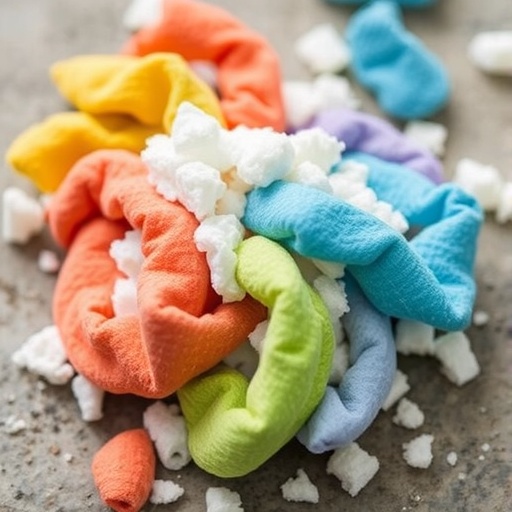In an innovative study recently published, researchers have unveiled the remarkable potential of Jará açu (Leopoldinia major) waste as an effective biosorbent for the removal of toxic dyes, including crystal violet and methylene blue, from aqueous effluents. This research not only highlights a sustainable solution for managing waste from the Amazon rainforest but also tackles a pressing environmental issue related to industrial dye pollution in water bodies.
Biosorption, a process through which contaminants are removed from aqueous solutions by biological materials, has gained considerable attention due to its applicability, efficiency, and cost-effectiveness. The study reveals that Jará açu waste, a byproduct generated from the harvesting of this native palm species in the Amazon, possesses significant sorption capabilities. By utilizing this often-overlooked resource, the researchers are paving the way for greener methods of pollution remediation.
The extraction of Jará açu waste presents a dual benefit: it aids in the disposal of palm waste while simultaneously providing an eco-friendly solution to hazardous dye pollution. The research team comprised scientists Diel, Netto, and dos Santos Nunes, who undertook rigorous experiments to test the biosorption efficiency of this natural material. Their findings indicate that Jará açu waste effectively binds to synthetic dyes, reducing their concentrations and thereby mitigating the pollution of water systems.
In an age where environmental sustainability and economic viability are paramount, the implications of this discovery are profound. The researchers employed a variety of methods to evaluate the biosorption properties, including adjusting the pH levels, temperature, and the concentration of dyes in the solution. Through these tests, they were able to optimize the conditions under which maximum dye removal could be achieved, showcasing the versatility and adaptability of Jará açu waste for various industrial applications.
One of the significant aspects of the study is the comparative analysis between Jará açu waste and traditional biosorbents. While many commercially available materials offer some level of efficacy, they often come with high costs and environmental footprints. In contrast, Jará açu waste is not only abundant but can also be obtained at little to no cost, making it an attractive alternative for industries seeking sustainable waste management solutions. The researchers argue that leveraging local biomaterials could revolutionize the approach to environmental pollution, particularly in regions like the Amazon.
Furthermore, the study underscores the potential for community engagement and economic opportunity through the utilization of Jará açu waste. Local populations can be empowered to valorize this underutilized resource and participate in the green economy by providing biosorbent materials for wastewater treatment. This participatory approach can lead to job creation, enhanced community well-being, and sustainable development while addressing pressing ecological challenges.
The extensive experimental work conducted by the research team solidifies the confidence in the biosorption capacities of Jará açu waste. Their findings revealed an impressive affinity for both crystal violet and methylene blue, noting that the biosorbent’s properties can be fine-tuned based on the waste treatment procedures implemented. The implications of such research extend beyond the removal of dyes; the potential for application in a broader spectrum of industrial effluent treatment is significant.
Moreover, the rising concern over water pollution and the quest for sustainable solutions have thrust biosorption techniques into the spotlight. As industrial processes continue to produce harmful waste, researchers are increasingly tasked with finding effective remedies that do not compromise environmental health. The findings from this study provide a beacon of hope that biowaste materials can play a crucial role in cleansing polluted water systems.
In light of the growing emphasis on sustainability, the use of Jará açu waste resonates perfectly within the context of the circular economy framework. By reusing agricultural byproducts, we can minimize waste and reduce the consumption of virgin materials, contributing to the overall ecological balance. This aligns with global efforts to combat climate change and operationalize sustainable practices across a spectrum of industries.
Importantly, the characteristics of the Jará açu biosorbent are not only confined to the realm of dyes. The study opens the door to further exploration of the material’s capabilities in adsorbing different types of pollutants, including heavy metals and organic compounds, thus expanding its applicability within environmental science. As further research unfolds, the potential to harness Jará açu waste in diverse settings may uncover even greater environmental benefits.
The collaboration of researchers in this field reflects a growing body of scientific literature advocating for sustainable practices that marry economic interests with ecological responsibility. The findings presented by Diel and colleagues are a testament to the transformative potential of using what nature offers to address some of the most pressing challenges of our time.
In conclusion, the exploration into the bio-sorption qualities of Jará açu waste signifies a critical step in environmental science. The successful removal of crystal violet and methylene blue dyes demonstrates not only a practical application but also a shift towards engaging with natural resources responsibly. As we look ahead, leveraging innovations such as these will be essential for developing effective strategies to mitigate pollution while simultaneously fostering economic growth in regions burdened with environmental challenges.
Together with emerging data from ongoing research, we are ripe for a future in which sustainable practices become the norm, and using waste as a valuable resource is not merely innovative but essential for preserving our ecosystem and nurturing a healthier planet.
Subject of Research: Biosorption of crystal violet and methylene blue dyes using Jará açu (Leopoldinia major) waste.
Article Title: Jará açu (Leopoldinia major) waste as a potent biosorbent from Amazonia for the removal of crystal violet and methylene blue dyes from aqueous effluents.
Article References:
Diel, J.C., Netto, M.S., dos Santos Nunes, I. et al. Jará açu (Leopoldinia major) waste as a potent biosorbent from Amazonia for the removal of crystal violet and methylene blue dyes from aqueous effluents.
Environ Sci Pollut Res (2025). https://doi.org/10.1007/s11356-025-37213-6
Image Credits: AI Generated
DOI: https://doi.org/10.1007/s11356-025-37213-6
Keywords: biosorption, Jará açu, environmental sustainability, dye pollution, wastewater treatment, Amazon rainforest.




